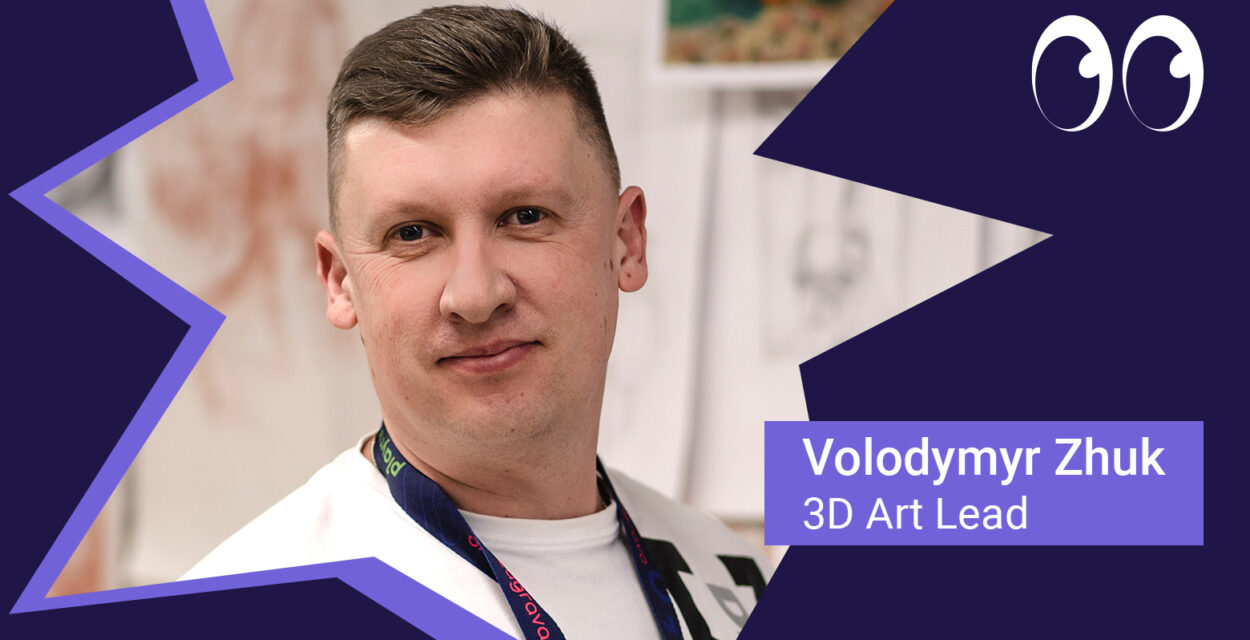How to start your career in 3D modelling?
Table of contents
- 1. Many make the mistake of searching for online/offline courses immediately after deciding to become a 3D modeler.
- 2. For a general understanding of how models are created in a real 3D department, rather than just on YouTube, let me explain to you how our pipeline is structured:
- 3. Let's summarize.

Vladimir Zhuk (Head of the 3D direction at Zagrava) shares.
“What courses would you recommend?” — literally everyone who has decided to pursue a career in 3D asks experienced modelers.
And as an experienced 3D artist, I can answer: “I wouldn’t recommend any.” Not because I’m unaware of them — quite the opposite.
In the context of standard algorithms and attempts to start the path of a modeler, I have two pieces of news for you: good and bad.
Let’s figure out what is worth starting with and what to pay attention to.
Many make the mistake of searching for online/offline courses immediately after deciding to become a 3D modeler.
Of course, you’re eager to learn everything as quickly as possible, but even with the continuous growth in popularity and use of 3D graphics, it remains a specific field that no beginner course can fully cover right away. The realm of 3D is highly diverse, and in production, there are usually no universal soldiers.
In this article, I propose a small action plan for you to progress from a simple desire to model to real career prospects through your own efforts, so hold off a bit on your courses. 🙂
Firstly, you need to determine: will you be modeling or animating?
Next — in which direction do you want to develop — for example, do you prefer hard surface or organic modeling, working with textures or scene lighting?
It all depends on your interests — you may love modeling machines, weapons, architecture, or want to create characters. It’s worth noting that achieving your goals is not guaranteed — your ability or inability to model or animate chosen objects also depends partly on talent — as with everything in the creative field.
Helping to develop this talent can come from a specific background — for example, an art school (since you want to call yourself a 3D artist, somehow).
The bad news is that general courses won’t immediately make you a specialist, they’ll only help you determine the main direction and show you the basic functions of the programs. But in reality, there’s no real necessity for this either, as you can also learn all of this on your own.
Choose the program you find most convenient to work with. While their functionality may be similar, typically each software is used for specific purposes. For example, for architectural tasks, 3D Max is the best choice, ZBrush has the most tools for sculpting, and high-quality, including cinematic animations, are most often created in Autodesk Maya. However, if you haven’t decided on your direction yet, you can play around with Blender.
Among its significant advantages: it develops very quickly, has a large community, it’s free, suitable for any tasks, and by the way, it’s often used in game development as well.
Overall, I recommend starting with ZBrush and then moving on to other software depending on the chosen direction.
After getting somewhat familiar with the functionality and tools, you can start creating simple models. Fortunately, there is an endless amount of tutorials available online, so all you need to do is set a specific task for yourself and search for a guide on how to accomplish it. With each new model, you’ll improve your skills, so over time, you’ll be able to determine how to implement various ideas on your own.
For fine-tuning your skills, self-education will also be sufficient — you can search for lessons on texturing, address your own “weak spots,” or even explore animation. Many diverse short courses can be found on LinkedIn Learning (formerly Lynda). They provide quality and accessible material, and you can also receive a certificate upon successful completion of the course, which you can attach to your resume or LinkedIn profile when job hunting.
For a general understanding of how models are created in a real 3D department, rather than just on YouTube, let me explain to you how our pipeline is structured:
• The modeler receives a task (usually a sketch drawn by an artist).
• Using ZBrush, they create a high-polygon object.
• The model is approved by the lead artist.
• Now, this model needs to be optimized (retopologized).
• A UV layout is prepared.
• After that, the model is handed over to the texturing specialist.
• Meanwhile, another specialist sets up the model for animation.
Once everything is approved, the model goes to the animator.
If you find that there’s insufficient (or conversely, too much) similar information available in open access, and you still aim to undergo a comprehensive educational course, then I advise you to carefully choose to ensure your time and money are not wasted in vain.
A strategy that works not only for 3D but for any industry: analyze the market and look for courses offered by companies you aspire to join – mostly they offer employment to the most talented graduates. By the way, it’s worth orienting yourself towards these graduates: if the course has been held before, usually they include works from students of previous cohorts in the announcement. You can evaluate the extent of knowledge and practice provided by the course, as well as the skills of the mentors overseeing these exemplary projects.
If students’ models after several months of the course look like your “masterpieces” after a few initial lessons on YouTube, it’s unlikely to be a worthwhile investment.
Also, keep in mind that learning is usually tied to a schedule, so to achieve results, you’ll need to timely go through lessons and keep up with the group to avoid being left alone with theoretical lectures.
The good news is that specialized courses do have their place and can indeed be very beneficial when you already know what you want. Yes, I advise using them precisely for professional development rather than a start. Signing up for a course is indeed worthwhile if among the instructors there are specialists who have worked on significant and well-known projects and have impressive experience, so pay attention to their portfolio too 🙂
“These courses will reveal to you some ‘secret techniques’ of real professionals and help you grasp specific things for which tutorials were hard to find.”
If you’re a character animator, from personal recommendations, I can mention Boris Klimov, whose portfolio includes “Mavka“. He had a course on Projector, and it offered an optimal balance between theory and practice.
Regardless of how you acquired your knowledge and skills, the most important aspect for future employment is your portfolio — it is through it (and in many cases, solely through it) that we evaluate candidates.
In 3D modeling, your higher education and course certificates don’t matter if you can’t present at least a few quality works. Yes, they should primarily be of high quality, so it’s better to include only a few, but perfectly executed models in your portfolio than to attach everything you have, even those for which you might feel embarrassed.
By the way, in our industry, among all platforms, publishing on Artstation will add the most “karma points” to you, but there too, it’s important to showcase only your best work.
Let’s summarize.
Personally, I would recommend the following algorithm:
• Suppose you feel that your calling is 3D modeling. Go to Artstation’s gallery and browse the works in the Awards section — this will be your ultimate goal and motivation.
• Armed with YouTube, create your first simple models. It’s important to go through the whole process: modeling, retopology, at least shading, and preferably texturing.
• Make a nice render and try to objectively evaluate the result.
• At this point, you should realize two things:
1. It’s not all that simple.
2. It doesn’t seem like a course will make it easier.
You might be thinking, “So… what to do next?”
And next — it’s all in your hands. Work and develop until you can formulate a clear question, the answer to which will be provided by a training course. Try different things until you realize what you really want. Use all the opportunities of the community: find modelers from whom you can learn something, ask more experienced artists for feedback, and, importantly, train your observation skills.
As mentioned above, on ArtStation, as well as on CGsociety.org, there is an Awards section where you can see the works of top artists. Orient yourself on them, get inspired, and do everything to one day join this hall of fame — that’s the best course I can recommend 🙂


